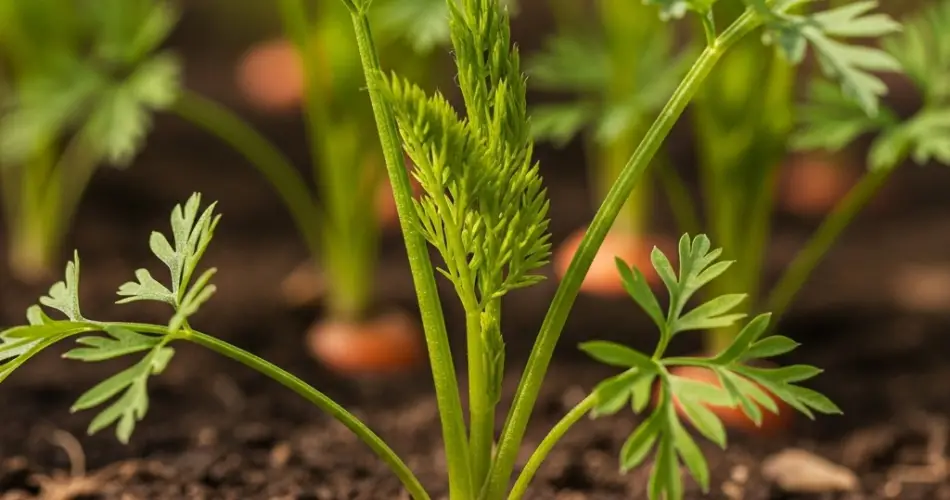Carrots are a rewarding crop for home gardeners, but to grow long, straight, and healthy roots, proper thinning is essential. Thinning is the process of removing excess seedlings to give the remaining carrots enough space to develop properly. If done carelessly, thinning can disturb or damage nearby roots, leading to deformed or stunted carrots. However, with the right technique and timing, you can thin carrots effectively without harming the roots that remain.
Here’s a step-by-step guide to thinning carrots the right way.
Why Thinning is Necessary
Carrot seeds are tiny and often sown thickly to ensure good germination. This results in clusters of seedlings growing too closely together. If not thinned, the carrots will compete for nutrients, light, and space, leading to:
-
Stunted growth
-
Twisted or forked roots
-
Reduced yield
-
Increased risk of disease due to poor air circulation
Thinning gives each carrot room to expand, promoting healthy root development and a more successful harvest.
When to Thin Carrots
Carrots should be thinned twice during their growing cycle:
-
First thinning – when seedlings are 1–2 inches tall (about 2–3 weeks after germination).
-
Second thinning – when carrots are about the width of a pencil (approximately 4–6 weeks after sowing).
Early thinning is crucial because carrots begin developing their roots soon after sprouting. Waiting too long can lead to root tangling and damage during the thinning process.
Ideal Spacing After Thinning
-
After the first thinning, leave about 1 inch (2.5 cm) between each seedling.
-
After the second thinning, aim for 2–3 inches (5–7.5 cm) between carrots, depending on the variety and expected mature size.
This spacing allows each root to grow straight and thick without crowding.
How to Thin Carrots Gently
Carrot seedlings are delicate, and their roots grow close together underground. Here’s how to thin them with minimal disturbance:
Method 1: Pinch and Snip
This is the safest method for the first thinning.
-
Identify the weakest or smallest seedlings in each cluster.
-
Using small scissors or garden snips, cut the seedling off at the soil line.
-
Avoid pulling the plant out, which can disturb the roots of neighboring carrots.
Tip: Do this after a watering or rain so the soil is soft, but not muddy. Moist soil reduces root disturbance.
Method 2: Gentle Pulling
Best for the second thinning, when the remaining seedlings are more spaced out and sturdy.
-
Water the bed a few hours before thinning to soften the soil.
-
Grasp the unwanted seedling low on the stem, close to the soil.
-
Gently wiggle and pull it out slowly, keeping an eye on neighboring seedlings.
-
If any nearby seedlings move, gently press the soil around their base to re-anchor them.
Tip: Use the pulled seedlings in salads if they’re clean and healthy—baby carrot greens are edible and slightly peppery.
Avoid Common Thinning Mistakes
-
Thinning too late: Waiting until roots are already crowded can damage the remaining plants and reduce yield.
-
Pulling aggressively: Tugging out seedlings from dry or compacted soil can uproot or disturb neighbors.
-
Thinning unevenly: Try to space carrots consistently to avoid pockets of overcrowding or large gaps.
-
Leaving gaps unfilled: After pulling, gently firm the soil around remaining seedlings to support their roots.
Care After Thinning
Once thinning is done, help your carrots recover with proper care:
-
Water thoroughly to settle the soil around roots and reduce transplant shock.
-
Mulch lightly with fine straw or compost to retain moisture and discourage weeds.
-
Keep the area weed-free so the carrots don’t have to compete for nutrients.
If any carrot tops appear disturbed or loosened, gently press the soil around them to help them stay upright and rooted.
Succession Sowing for Continuous Harvest
Instead of planting all your carrots at once, try sowing a new row every 2–3 weeks. This provides a staggered harvest and reduces the pressure to thin all your carrots at once. Smaller batches are easier to manage, and you’ll enjoy a steady supply throughout the season.
Final Thoughts
Thinning may seem like a chore, but it’s one of the most important steps in growing high-quality carrots. Done with care, it allows the strongest seedlings to thrive and ensures that your carrots grow straight, sweet, and full-sized. Whether you choose to snip or pull, remember that gentleness and timing are key. With this knowledge, you can confidently thin your carrot patch and look forward to a bountiful harvest of healthy, beautiful roots.



